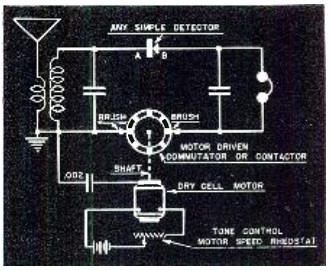 A hundred years ago this month, the December 1917 issue of Wireless Age showed this method of received undamped waves (CW) with a crystal detector. Unlike spark signals, the CW signals had no audio modulation. Therefore, with just a crystal set, you can’t hear anything.
A hundred years ago this month, the December 1917 issue of Wireless Age showed this method of received undamped waves (CW) with a crystal detector. Unlike spark signals, the CW signals had no audio modulation. Therefore, with just a crystal set, you can’t hear anything.
The conventional method to receive CW signals is with a receiver that has a BFO, an oscillator that mixes with the incoming signal. When the CW signal is transmitted, you hear a tone which is the difference between the frequencies of the two signals.
This circuit uses a rotating variable condenser in the circuit. The article includes alternate placements, but the idea is the same. An audio frequency (the same as the frequency of the motor’s rotation) is imposed on the signal, and the code can be copied in the headphone. The pitch you hear is equal to the frequency at which the capacitor is rotating.
 We previously showed a similar idea from 1943 in this post. In this circuit, CW can be copies by interrupting the circuit with a motor driving a commutator.
We previously showed a similar idea from 1943 in this post. In this circuit, CW can be copies by interrupting the circuit with a motor driving a commutator.
